

How To Think & Learn... Training the Brain to Listen: A Practical Strategy for Student Learning and Classroom Management. Image credit: iStockphoto Editor's note: This post is co-authored by Marcus Conyers who, with Donna Wilson, is co-developer of the M.S. and Ed.S.
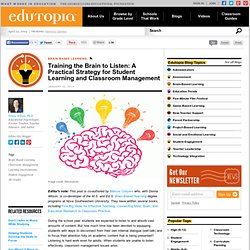
Brain-Based Teaching degree programs at Nova Southeastern University. They have written several books, including Five Big Ideas for Effective Teaching: Connecting Mind, Brain, and Education Research to Classroom Practice. The Thinking Classroom: Ways of Thinking. Effective thinking-centered instruction aims to achieve two educational objectives: To cultivate the active use of knowledge, and To help students become self-regulated learners.

Toward that end, this section of The Thinking Classroom highlights four thinking-centered approaches for infusing high-level thinking instruction into your regular curriculum. חשיבה מסדר גבוה. 8 Brain Research Discoveries Every Instructional Designer Should Know About. Brainy Approaches to Learning Infographic. Teacher Infographics We know that each student is unique, but what about each student’s brain?

Understanding how the brain works when learning is key to helping students achieve mastery of a subject or topic. Room233 - More examples. Brainy Approaches to Learning Infographic. 1299064473-multitasking-effect-on-brain.png (PNG Image, 1000 × 2193 pixels) - Scaled (30%) Critical Thinking: Definitions and Assessments. January 3, 2013 By: Maryellen Weimer, PhD in Educational Assessment Despite almost universal agreement that critical thinking needs to be taught in college, now perhaps more than ever before, there is much less agreement on definitions and dimensions.
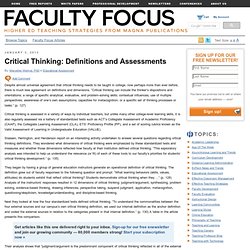
“Critical thinking can include the thinker’s dispositions and orientations; a range of specific analytical, evaluative, and problem-solving skills; contextual influences; use of multiple perspectives; awareness of one’s own assumptions; capacities for metacognition; or a specific set of thinking processes or tasks.” (p. 127) Stassen, Herrington, and Henderson report on an interesting activity undertaken to answer several questions regarding critical thinking definitions. They began by having a group of general education instructors generate an operational definition of critical thinking. Next they looked at how the four standardized tests defined critical thinking. Despite these limitations, other benefits derive from this kind analysis. Brainy Approaches to Learning Infographic. How Technology Wires the Learning Brain.
Kids between the ages of 8 and 18 spend 11.5 hours a day using technology — whether that’s computers, television, mobile phones, or video games – and usually more than one at a time.

That’s a big chunk of their 15 or 16 waking hours. But does that spell doom for the next generation? Not necessarily, according to Dr. Gary Small, a neuroscientist and professor at UCLA, who spoke at the Learning & the Brain Conference last week. “Young people are born into technology, and they’re used to using it 24/7,” Small said. “The technology train has left. The downside of such immersion in technological devices, he said, is that they’re not having conversations, looking people in the eye, or noticing verbal cues. Brain-Based Learning. Resources and Downloads for Teaching Critical Thinking.
Tips for downloading: PDF files can be viewed on a wide variety of platforms -- both as a browser plug-in or a stand-alone application -- with Adobe's free Acrobat Reader program.
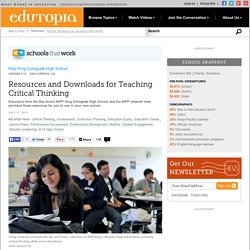
Click here to download the latest version of Adobe Reader. Click on any title link below to view or download that file. Resources On This Page: Lesson Plans & Rubrics. 3 Strategies to Promote Independent Thinking in Classrooms. Imagine the intentional focus you would bring to crossing a rushing creek.
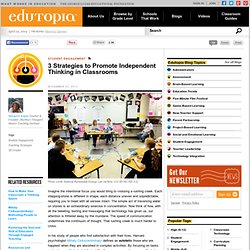
Each stepping-stone is different in shape, each distance uneven and unpredictable, requiring you to tread with all senses intact. The simple act of traversing water on stones is an extraordinary exercise in concentration. Now think of how, with all the tweeting, texting and messaging that technology has given us, our attention is frittered away by the mundane.
The speed of communication undermines the continuum of thought. That rushing creek is much harder to cross. In his study of people who find satisfaction with their lives, Harvard psychologist Mihaly Csikszentmihalyi defines as autotelic those who are happiest when they are absorbed in complex activities. Teachers can utilize three strategies to cultivate improved focus: sequencing instruction, recovery from mistakes, and setting goals. 1. Finding intriguing ways to sequence information is one method for promoting students' sense of discovery. New Interesting Chart on Growth Vs Fixed Mindsets. I first come across the concept of fixed versus growth mindset through the works of the socio-linguist Barlow and since then I have seen a plethora of visuals and graphics on this very same concept some of which I shared in this page.
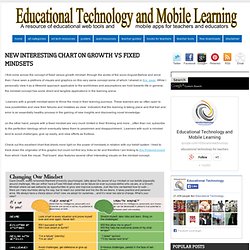
While I personally view it as a lifeworld approach applicable to the worldviews and assumptions we hold towards life in general, the mindset concept has some direct and tangible applications in the learning arena. Learners with a growth mindset seem to thrive the most in their learning journeys. How Design Thinking Can Empower Young People. Daniel: For kids who really feel like most of life happens to them, for them to have an opportunity to feel that they have an impact is very exciting.
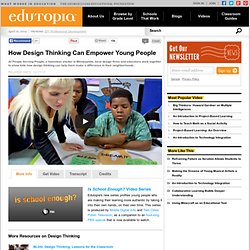
The D3 program is designed specifically for teenagers. And they feel that it's really relevant to their lives, and relevant to the community here, People Serving People. Emily: One, two, three, jump! Helping Learners Remember What They Learn: 4 Time-Tested Principles. Helping Learners Remember What They Learn: 4 Time-Tested Principles Highly competent instructional designers and professionals now make the most out of scientific research.

They usually incorporate new insights, test them and repeat what works. Over time, the weaker insights falter then fade while the stronger ones remain. These scientific principles that stood the test of time are really worth looking at.